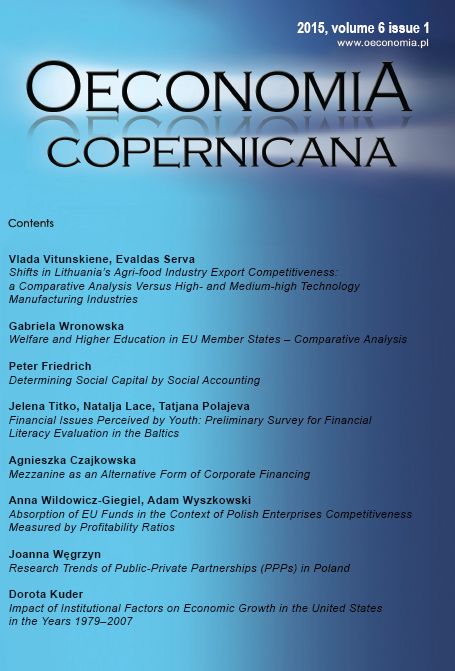Impact of institutional factors on economic growth in the United States in the years 1979?2007
DOI:
https://doi.org/10.12775/OeC.2015.008Keywords:
economic growth, new institutional economics, regression functionAbstract
The purpose of this article is to isolate and determine the importance of institutional arrangements in shaping the dynamics of the U.S. GDP in the years 1979?2007. The research hypothesis which has been verified here can be summarized as follows: institutions in the U.S. economy have a positive influence on economic growth through a significant impact on improving the business environment. Having regard to the division of the economy into institutional areas: economic system, labor market, financial market, education and R&D, the author selected these institutional factors which indicated that the operation could be important for the process of economic growth in the United States, and then measured the impact in the years 1979?2007. To verify the thesis about the impact of institutions on economic growth the author used one of the most popular tools in this kind of econometric research ? the multiple regression analysis. The analysis revealed that during the period of all the analyzed institutional factors it was the proportion of the working population and the degree of unionization that most strongly influenced the economic growth of the United States ? an increase in one of these factors was associated with a much more than proportional increase in the rate of the economic growth.
Downloads
References
Acemoglu, D., Johnson, S., & Robinson, J. A. (2001). Reversal of Fortune: Geography and Institutions in the Making of the Modern World Income Distribution. NBER Working Paper, No. 8460.
Acemoglu, D., Johnson, S., & Robinson, J. A. (2005). Institutions as a Fundamental Cause of Long-Run Growth. In: P. Aghion and S. N. Durlauf (Ed.), Handbook of Economic Growth, Vol. 1, Part A, Elsevier.
Acemoglu, D., Johnson, S., Robinson, J. A., & Thaicharoen, Y. (2003). Institutional Causes, Macroeconomic Symptoms: Volatility, Crises and Growth. Journal of Monetary Economics, 50(1).
Amable, B. (2003). The Diversity of Modern Capitalism. Oxford?New York: Oxford University Press.
Aron, J. (2000). Growth and Institutions: A Review of the Evidence. The World Bank Research Observer, 15(1).
Beaudry, P., Green, D. A., & Sand, B. M. (2010). How Much Is Employment Increased by Cutting Labor Costs? Estimating the Elasticity of Job Creation. NBER Working Paper, No. 15790, February.
Blanchard, O., & Portugal, P. (2001). What Hides behind an Unemployment Rate: Comparing Portuguese and US Labor Market. American Economic Review, 91(1).
Botero, J., Djankov, S., Porta, R.L., Silanes F. L., & Shleifer, A. (2004). The Regulation of Labor. Quarterly Journal of Economics, 119( 4).
Brzozowski, M., Gierłatowski, P., Milczarek, D., & Siwnińska-Gorzelak, J. (2006). Instytucje a polityka makroekonomiczna i wzrost gospodarczy. Warszawa: Wydawnictwo Uniwersytetu Warszawskiego.
Carmignani, F. (2009). The Distributive Effects of Institutional Quality When Government Stability is Endogenous. European Journal of Political Economy, 25(4).
Doeringer, P. B., & Streeten, P. P. (1990). How Economic Institutions Affect Economic Performance in Industrialized Countries: Lessons for Development. World Development, 18(9).
Easterly, W., & Levine, R. (2003). Tropics, Germs, and Crops: How Endowments Influence Economic Development. Journal of Monetary Economics, 50.
Economic Report of the President (2010). Council of Advisers. Washington D.C: United States Government Printing Office, Retrived from http://www.gpoaccess.gov/eop/ (1.012014).
Hall, R. E., & Jones, C. I. (1999). Why Do Some Countries Produce So Much More Output per Worker than Others?. Quarterly Journal of Economics, 114(1).
Kuder, D. (2008). Instytucje wspierające wzrost gospodarczy w wymiarze teoretycznym. In: D. Kopycińska (Ed.). Polityka ekonomiczna państwa we współczesnych systemach gospodarczych. Szczecin: Wydawnictwo Uniwersytetu Szczecińskiego.
Levine, R., & Renelt, D. (1992). A Sensitivity Analysis of Cross-Country Growth Regressions. American Economic Review, 82(4).
Moers, L. (1999). How Important are Institutions for Growth in Transition Countries? Tinbergen Institute Discussion Papers No. 99-004/2, Tinbergen Institute, Amsterdam.
Nabli, M. K. (1989). The New Institutional Economics and its applicability to development. World Development, 17(9).
North, D. C. (1990). Institutions, Institutional Change and Economic Performance. New York: CambridgeUniversity Press.
North, D. C. (1989). Institutions and economic growth: An historical introduction. World Development, 17(9).
OECD (2010). Employment Outlook 2010.
OECD (2012). Employment Outlook 2012.
Ogilvie, S., & Carus A. W. (2014). Institutions and Economic Growth in Historical Perspective. In: P. Aghion, S. N. (Eds.). Durlauf Handbook of Economic Growth, Vol. 2. Elsevier.
Rodrik, D. (2004). Getting Institutions Right. Retrived from: http://www.sss.ias.edu/faculty/rodrik/papers (1.012014).
Rodrik, D., Subramanian, A., & Trebbi, F. (2002). Institutions Rule: The Primacy of Institutions over Geography and Integration in Economic Development, NBER Working Paper, No. 9305.
Rodrik, D. (2000). Institutions for High Quality Growth: What They Are and How to Aquire Them? NBER Working Paper No. 7540.
Stiglitz, J. E. (2000). Challenges in the Analysis of the Role of Institutions in Economic Development, Villa Bording Workshop Series ?The Institutional Foundations of a Market Economy?.
U. S. Bureau of Labor Statistics (2010). U.S. Bureau of Labor Statistics. Reterived from: http://www.bls.gov/ (1.01.2014).
U.S. Census Bureau. The 2012 Statistical Abstract of the United Stated of America, Retrived from: http://www.census.gov/compendia/statab/ (1.01.2014).
U.S. Department of Commerce (2010). Bureau of Economic Analysis. Retrived from: http://bea.gov/ (1.01.2014).
U.S Department of Labor (2010). Labor Force Statistics from the Current Population Survey. Retrived form: http://www.bls.gov/ (1.10.2010).
Ząbkowicz, A. (1998). Państwo a źródła niepewności instytucjonalnej. Ekonomista, 5?6.
Zienkowski, L. (2008). Determinanty i perspektywy wzrostu gospodarczego w nadchodzących latach ? próba syntezy. In: Polska transformacja i jej przyszłość. Warszawa: PWE.






